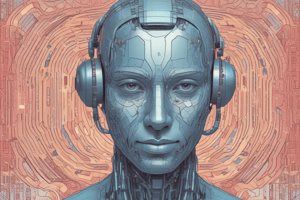Podcast
Questions and Answers
Which of the following is NOT an example of a task AI systems are able to perform?
Which of the following is NOT an example of a task AI systems are able to perform?
- Analyzing user preferences to make recommendations
- Making decisions based on collected data
- Providing customer support through chatbots
- Completing manual tasks like typing and filing documents (correct)
What is the primary goal of digital transformation for businesses?
What is the primary goal of digital transformation for businesses?
- To adopt the latest technology regardless of its impact
- To increase production and improve overall efficiency (correct)
- To eliminate the use of paper-based systems
- To replace human employees with machines
Which of these is an example of a real-world application of AI in the field of entertainment?
Which of these is an example of a real-world application of AI in the field of entertainment?
- Using a movie recommendation system based on user preferences (correct)
- Using a spreadsheet to track movie ticket sales
- Creating a website to stream movies online
- Booking a movie ticket through a website
How do AI systems improve their performance over time?
How do AI systems improve their performance over time?
Which of the following is NOT a characteristic of digital transformation?
Which of the following is NOT a characteristic of digital transformation?
Which machine learning type involves providing the algorithm with labeled data to train it for predictions?
Which machine learning type involves providing the algorithm with labeled data to train it for predictions?
Which of these is NOT a key ethical consideration in AI development?
Which of these is NOT a key ethical consideration in AI development?
Which of the following is an example of how AI is impacting the healthcare industry?
Which of the following is an example of how AI is impacting the healthcare industry?
A chatbot that learns from each interaction with a user to better understand their preferences is an example of which AI concept?
A chatbot that learns from each interaction with a user to better understand their preferences is an example of which AI concept?
Which of these is NOT a key concept within the domain of Artificial Intelligence (AI)?
Which of these is NOT a key concept within the domain of Artificial Intelligence (AI)?
What is the primary function of a Neural Network in AI?
What is the primary function of a Neural Network in AI?
Which of these is an example of how AI is being used in the retail industry?
Which of these is an example of how AI is being used in the retail industry?
Which machine learning type involves training algorithms through trial-and-error interactions with an environment and receiving rewards based on performance?
Which machine learning type involves training algorithms through trial-and-error interactions with an environment and receiving rewards based on performance?
What is the core concept behind the concept of bias and discrimination in the context of AI ethics?
What is the core concept behind the concept of bias and discrimination in the context of AI ethics?
Flashcards
Digital Transformation
Digital Transformation
The process of changing work from paper-based to digital technologies.
Impact of Digital Transformation
Impact of Digital Transformation
It significantly affects both businesses and society by improving work and production.
Artificial Intelligence (AI)
Artificial Intelligence (AI)
A field focused on developing machines that simulate human intelligence and decision-making.
Recommendation Engines
Recommendation Engines
Signup and view all the flashcards
Chatbots
Chatbots
Signup and view all the flashcards
Machine Learning (ML)
Machine Learning (ML)
Signup and view all the flashcards
Neural Networks
Neural Networks
Signup and view all the flashcards
Natural Language Processing (NLP)
Natural Language Processing (NLP)
Signup and view all the flashcards
Supervised Learning
Supervised Learning
Signup and view all the flashcards
Unsupervised Learning
Unsupervised Learning
Signup and view all the flashcards
Reinforcement Learning
Reinforcement Learning
Signup and view all the flashcards
Data Ethics
Data Ethics
Signup and view all the flashcards
Supervised Learning Example
Supervised Learning Example
Signup and view all the flashcards
Impact of AI
Impact of AI
Signup and view all the flashcards
Accountability in AI
Accountability in AI
Signup and view all the flashcards
Study Notes
Digital Transformation
- Involves changing work processes from paper-based or simple tech to advanced digital systems.
- Aims for increased productivity and improved efficiency.
- Impacts businesses and society significantly.
- Examples include:
- Shifting from printed correspondence to online communication.
- Replacing traditional entertainment like cinemas with streaming services.
Artificial Intelligence (AI)
- Focuses on building intelligent machines, specifically smart computer programs.
- AI systems mimic human intelligence for tasks and decision-making.
- Continuously learns and improves with collected data.
- Examples:
- Recommendation Engines:
- Provide automated suggestions (e.g., shopping, TV shows).
- Use algorithms to analyze user preferences and propose related content.
- Examples include YouTube, Amazon, and LinkedIn.
- Chatbots:
- AI-powered customer support agents.
- Understand customer issues and offer solutions.
- Handle basic inquiries, freeing up human agents.
- Smart Assistants:
- Manage tasks and schedules by processing personal info (emails, texts).
- Examples include Siri (Apple), Alexa (Amazon), and Cortana (Microsoft).
- Recommendation Engines:
Key AI Concepts
- Machine Learning (ML):
- A subset of AI focusing on algorithms for computers to learn from data patterns.
- Enables prediction, classification, and decision-making based on data patterns.
- Example includes using chatbot interactions to understand user traits.
- Neural Networks:
- A type of ML algorithm, inspired by the human brain's structure and function.
- Mimics interconnected neurons for complex learning and processing.
- Natural Language Processing (NLP):
- Enables computers to understand and generate human language (written and spoken).
- Crucial for creating chatbots and AI capable of natural human-like communication.
Types of Machine Learning
- Supervised Learning:
- Algorithms trained on historical labeled data to predict outcomes on new data.
- Relies on labeled data to teach desired output for a given input.
- Examples include:
- Regression Analysis: Predicting numerical values (e.g., stock prices).
- Classification Analysis: Categorizing data (e.g., identifying images of cats or dogs).
- Unsupervised Learning:
- Algorithms learn from unlabeled data without explicit user guidance.
- Discovers patterns and structures within the data itself.
- Example: Categorizing customers based on purchase history for targeted marketing.
- Reinforcement Learning:
- Algorithms learn through interaction with an environment, receiving rewards or penalties.
- Learns optimal actions through trial and error, similar to human learning.
- Example: Training a computer to play chess, rewarding good moves and penalizing bad ones.
Data Ethics in AI
- Privacy: Protecting individual data from unauthorized access.
- Bias and Discrimination: Ensuring algorithms are fair and unbiased to prevent prejudice.
- Social Impact: Considering wider societal implications of AI applications and their influence on jobs and the environment.
- Accountability: Establishing clear responsibility for AI system decisions, promoting transparency and accountability for outcomes.
Impact and Applications of AI
- New Jobs: AI creates new roles in software development, data science, and AI engineering.
- Applications across Industries: AI impacts various sectors including:
- Manufacturing: Optimizing production efficiency, automation.
- Retail: Forecasting customer needs, improved marketing efforts.
- Urban Planning: Managing resources, optimizing traffic flow.
- Healthcare: Enhancing medical diagnoses, improving patient care.
- Finance: Analyzing financial data, investment recommendations.
- Transportation: Developing self-driving vehicles, improving traffic management.
Conclusion
- AI is rapidly advancing, significantly impacting daily life.
- Understanding AI concepts and ethical considerations are essential for navigating the technological world.
- AI has the potential for positive change, demanding responsible development and deployment practices to address inherent ethical concerns.
Studying That Suits You
Use AI to generate personalized quizzes and flashcards to suit your learning preferences.




